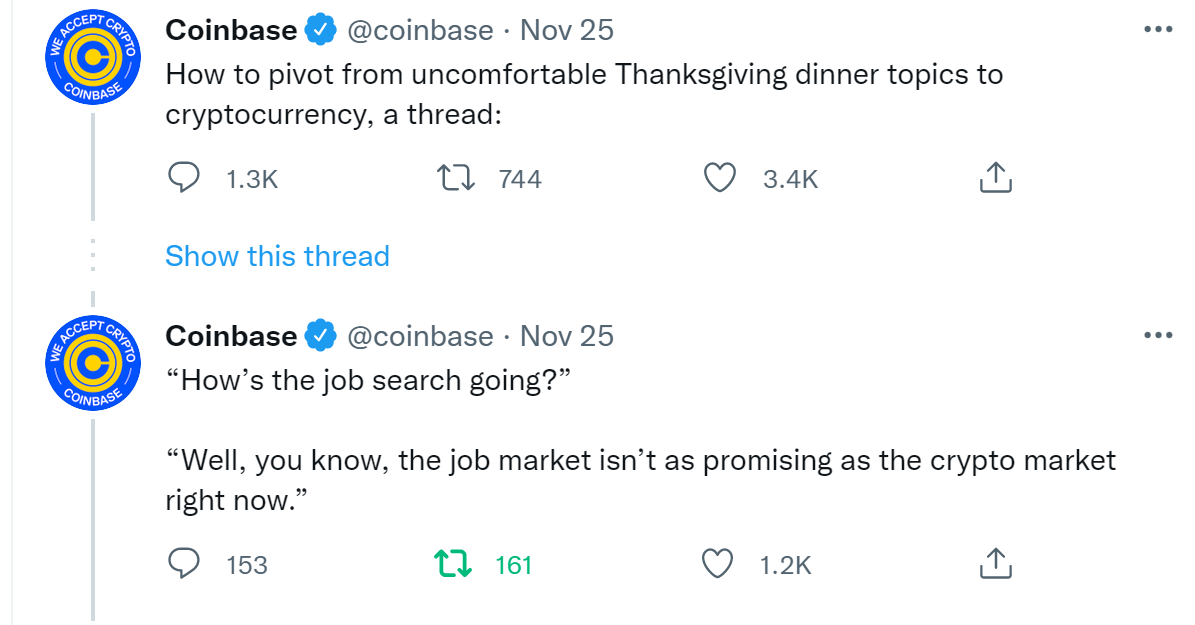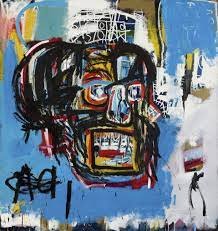Art 3.0
So, I just dealt with that awkward Thanksgiving dinner talk. I was warned - mostly on Twitter, by others who were about to experience the same thing. It started with excitement, positivity, but quickly derailed itself into a lengthy discussion, some judgement, and numerous accusations and bets. Really, it was my fault.
I brought up crypto.
Coinbase saving the day
Coinbase was smart enough (great marketing) to provide a number of great talking points on the subject for all of us who might experience it when we get home, but nothing stuck. I was in the middle of a battle without any assistance.
NFTs are a scam. The first blow.
Crypto will all come falling down. The second, I am down for the count.
I just don’t want you to get hurt. The third, and the most heavy blow. Caring tied with judging.
But then I realized something. There are a lot of people that just don’t get it, largely because there is too much stuff going on in the world to devote more time to new stuff. The fact that I live in this little microcosm everyday probably helps me see through a lot of the bullshit, while giving me a healthy dose of the other kind of bullshit. I get it all.
Although I just want to talk about NFTs and how they pertain to the art world, I am just going to quickly touch upon one idea;
True or false
If we agree that web 3.0 is a thing, and Facebook’s 10 billion dollar investment in the metaverse is a sign of that, we must conclude that this new world will likely operate with a new kind of currency.
But further to that, if we believe web 3.0 is a real thing, that is not a scam, we must also conclude that Ethereum, the technology that is the foundation of DeFi, and NFT’s, is also not a scam.
Which then sort of leads us down this meandering path of asking if certain tokenized services that build up the infrastructure of the metaverse, typically referred to as alt coins, are important, we must conclude that although very volatile, are also probably not a scam.
The problem right now is people brush the space off immediately because of the 10,000,00 X returns on certain, more media worthy, assets. Nobody has time to go down the rabbit hole. Its not surprising that the executive chairman of Santander, one of the biggest banks in the world, recently said, while announcing they are working on a bitcoin ETF, that crypto is the next big thing.
The next big thing, which is actually already here, is crypto. - Ana Botin, executive chairman of Santander
Now, back to art and NFTs.
I know a number of traders, flippers, creators and apes, so I am exposed to a healthy amount of all sides of the current wild west of NFTS. Addressing this idea that “ the bubble will pop” is easy.
It will. It does. And it happens multiple times per day.
But that doesn’t mean that the movement towards NFTs will entirely pop, or slow down because of the underlying technology and innovation that NFTs provide to the art space, and many other spaces.
Crypto Dick Butt - maybe a bubble?
Everyday, dozens of projects drop. These are all spin offs of some of the original blue chip projects - the punks and the apes. Simple projects that provided the user with an avatar, a community to spend time with and exchange ideas, and a roadmap full of some other neat things. These projects exploded, and hold value because they are the turning point in how we engage with digital assets. Some of these projects are great, but many of them go through a very short lived hype bubble driven mostly by quick flippers. People that want to make a couple thousand bucks, many times per day. They drive the hype, and the projects go up, and then drop. The bubble bursts. However - if you were smart enough to invest in the right project, you are still holding onto something that lets you access the features, utility and community of that project. For example, Bitcoin Billionaires recently airdropped an ape to one of its owners, valued at $250,000. The NFT that person bought was $500.
The 2nd of 3 airdrops from the Bitcoin Billionaire NFT.
Then and now
30 years ago, Jean-Michel Basquiat created some amazing work. Back then, you could buy a Basquiat for $50,000. They now sell for over 10 million. But what if today, somewhere, this generation's Basquiat is sitting at home creating art that will change the world, but he’s doing it on Photoshop, Blender, or Cinema4d. How do you buy it? How do you invest in him? How do you support him? And how do you eventually sell any work you purchased - if there is no way to tell if there are other copies out there? If value is tied to the original piece of art - the one and only, how do you differentiate?
Or do we expect that today’s digital artists simply can’t make a living selling art?
So here is your NFT cheat sheet:
Buyer: You can invest in a new generation of artists, get exposed to more art, and can interact directly with the seller without requiring a middle man (hey look, web 3 strikes again). You can sell the original for a return, just like the old art world, but now, the market is much much bigger. You can place your money into an asset and let it appreciate, if you do your homework.
Seller: You can create digital art, price it like regular art, sell it and let people hang it. You don’t need to give it away for free, exchanging your art for likes. You can get paid a royalty for every transaction.
Viewer. This doesn’t change much for random viewers that are not in the transaction. But neither did the previous art world. Most great art is on display in museums. It’s secure. You can pay to go look at it, but you don’t own it, and can’t benefit from its price increases, or any additional value that is provided by owning it, the network, and with NFTs, the utility.
Token for a fool
For a very long time now, the art world has been dealing with a steady onslaught of forgeries. It is estimated that over 50% of blue chip art is forged. This means that every time art is bought or sold, it requires rigorous inspection, which does not always guarantee results. This is solved immediately with NFT’s, as the entire transaction history, from birth, are traceable on the block chain.
The future is already yesterday
For over a thousand years, artists have taken colored liquids, and applied them to rectangular fabric (for one example). The images have changed, but not much else has. Now, we have artists that have built on top of the foundations of the masters, and have been given new technology to work with. And now, finally, we can assign value, and scarcity to these images. We have finally bridged the gap between the traditional art world, and digital art. But don’t take my word for it, Art Basel, one of the biggest art fairs in the world, seems to think the same way.
The art world was due for some major disruption, and it has finally arrived. The question is, how will you get involved?




